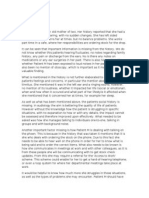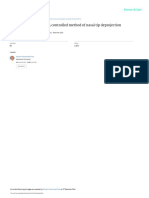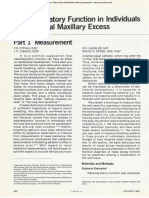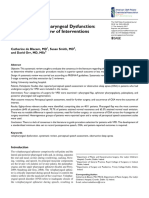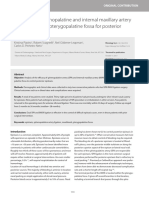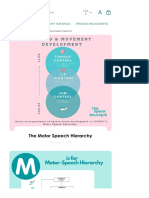Schlosser 1999
Schlosser 1999
Uploaded by
ngocphuc190197Copyright:
Available Formats
Schlosser 1999
Schlosser 1999
Uploaded by
ngocphuc190197Original Title
Copyright
Available Formats
Share this document
Did you find this document useful?
Is this content inappropriate?
Copyright:
Available Formats
Schlosser 1999
Schlosser 1999
Uploaded by
ngocphuc190197Copyright:
Available Formats
ORIGINAL ARTICLE
Surgery for the Dysfunctional Nasal Valve
Cadaveric Analysis and Clinical Outcomes
Rodney J. Schlosser, MD; Stephen S. Park, MD
Objectives: To quantify changes in the cross-sectional daveric valves. Functional and aesthetic results were de-
area of the nasal valve after placement of spreader grafts termined by nasal patency scores from 1 (complete ob-
and flaring sutures and to review clinical outcomes after struction) to 10 (complete patency) and a rating of
nasal valve surgery. postsurgical cosmetic changes.
Design: The minimal cross-sectional area of cadaveric na- Results: Spreader grafts improved the cadaveric mini-
sal valves was measured after placement of spreader grafts mal cross-sectional areas by 5.4% (P..05), flaring
and flaring sutures. Clinical outcomes for patients under- sutures by 9.1% (P..05), and spreader grafts combined
going functional rhinoplasty were retrospectively reviewed. with flaring sutures by 18.7% (P,.05). Mean nasal pat-
ency scores improved from 3.4 to 6.5 (P,.01) with the
Setting: Academic medical center. combination of spreader grafts and flaring sutures. Car-
tilaginous battens improved scores from 2.7 to 6.3
Subjects: Six fresh cadaver heads and a review of pa- (P,.01).
tients from September 1994 through May 1998.
Conclusions: The combination of flaring sutures and
Intervention: Acoustic rhinometry was performed after spreader grafts has the greatest impact on the cadaveric
placement of spreader grafts, flaring sutures, and the two nasal airway. Either technique alone failed to have a sta-
together. Clinically, a site-specific repair was performed with tistically significant impact on the minimal cross-
spreader grafts and flaring sutures for statically narrowed sectional area of the nasal valve. Clinical review con-
internal nasal valves and cartilaginous battens for dy- firms significant improvement in nasal function using this
namic collapse. combination technique.
Main Outcome Measure: Cross-sectional areas of ca- Arch Facial Plast Surg. 1999;1:105-110
N
ASAL VALVE dysfunction nal nasal valve consists primarily of the
has a role in up to 13% fibrofatty tissues of the alar lobule and,
of adults complaining of to a lesser extent, the lower lateral carti-
chronic nasal obstruc- lages, the caudal septum, and the piri-
tion,1 and yet this ana- form aperture.3,4 The entire nasal valve
tomical and dynamic factor continues to complex is bounded superiorly by the
be overlooked by many otorhinolaryn- reflection between the caudal end of the
gologists. Physiological obstructions, such upper lateral cartilages and the septum,
as mucosal congestion and allergic rhini- posteriorly by the head of the inferior
tis, can have a significant impact on the turbinate, inferiorly by the floor of the
nasal airway.2 Once these reversible com- nose, and laterally by the bony piriform
ponents have been satisfactorily ad- aperture and its adjacent fibrofatty tissue.
dressed, structural and anatomical changes The normal cross-sectional area of the
to the nasal skeleton can be considered. nasal valve is between 55 and 83 mm2
The internal nasal valve is defined and is the site of highest nasal resis-
as the area between the caudal end of the tance.5-8 It functions as the primary regu-
From the Department of upper lateral cartilages and the cartilagi- lator of airflow, providing physiological
Otolaryngology–Head and nous septum. This angle is normally 10° resistance and the sensation of normal
Neck Surgery, University of to 15° in the white (leptorrhine) nose nasal airway patency.3 External devices
Virginia Medical Center, and is more obtuse in African American to alter the valve area are frequently used
Charlottesville. and Asian (platyrrhine) noses. The exter- by professional athletes, and it has been
ARCH FACIAL PLAST SURG/ VOL 1, APR-JUNE 1999
105
©1999 American Medical Association. All rights reserved.
Downloaded From: http://archfaci.jamanetwork.com/ by a University of North Dakota User on 05/23/2015
MATERIALS AND METHODS A history of seasonal variation, alternating sides, or ex-
cessive use of topical decongestants indicates that there may
be a nonanatomical element involved. Also, valve obstruc-
CADAVER STUDIES tion may be mild at rest (in the clinic chair) but signifi-
cantly exacerbated during strenuous aerobic exercise, dur-
Cross-sectional areas of nasal cavities in 6 fresh cadaver ing which vigorous nasal respiration is used. Other individuals
heads were measured using acoustic rhinometry (Eccovi- complain of unilateral nasal obstruction while lying in a de-
sion; Hood Laboratories, Pembroke, Mass). The minimal cubitus position with the flaccid side up, where gravity ac-
cross-sectional area (MCA) at the level of the nasal valve centuates sidewall collapse. Physical examination begins with
was determined before any incisions were made. Septal car- inspection of the nose, both at rest and during inspiration.
tilage was harvested from the first cadaver head through a Anterior and base views can reveal specific areas of narrow-
standard hemitransfixion incision and fashioned into ing, such as the “hourglass” deformity seen with a narrow
spreader grafts 1 to 2 mm thick. These grafts were used with internal nasal valve due to upper lateral cartilage collapse.
all heads throughout the investigation to ensure unifor- Normal inspiration may demonstrate unusual flaccidity of
mity. An open rhinoplasty approach was used for all graft- the sidewall or alar lobule. Direct inspection of the internal
ing and suture techniques, and the soft tissue envelope was nasal valve must be done while minimizing the distortion
redraped before the rhinometric data were collected. Re- from a nasal speculum. A cotton-tip applicator is useful for
petitive acoustic clicks were used until a reproducible graph supporting specific points intranasally and identifying those
was obtained and thought to represent the cross-sectional areas that most improve airflow. A distinction is made be-
area of the nasal passage. Four measurements were ob- tween collapse from the sidewall and a deflected dorsal sep-
tained from each side of the nose: (1) after degloving, (2) tum, as both can contribute to the narrow internal valve.
flaring suture alone, (3) spreader graft alone, and (4) flar- Once the dysfunctional element(s) of the internal or
ing suture and spreader graft together. Lateral battens were external valve has been determined, a site-specific treat-
not studied because they are not designed to change the ment plan is formulated. We begin by correcting major de-
resting MCA. formities of the septum and nasal bones, and then we re-
evaluate the patency of the valves. Displaced nasal bones
CLINICAL DATA COLLECTION distort the cephalic margin of the underlying upper lateral
cartilages and can dramatically alter the nasal valve angle.
We reviewed the medical charts and operative reports of all Accurate reduction with osteotomies may be the most di-
patients who underwent rhinoplasty, septorhinoplasty, or na- rect means of addressing internal valve stenosis.
sal reconstruction between September 1, 1994, and May 30, Static collapse of the sidewall causing valve obstruc-
1998. The patient population for this study was limited to tion is repaired with spreader grafts and/or flaring su-
individuals undergoing procedures to alleviate nasal obstruc- tures. Valve dysfunction due to a dynamic collapse of the
tion due to valve dysfunction. Those with isolated septal de- lateral crura or alar fibrofatty tissue is corrected using alar
viation, nasal bone dislocation, or polyposis were excluded. batten grafts placed directly over the site of collapse. Se-
Each patient was directly contacted to obtain functional out- lect cases of tip ptosis may cause enough narrowing of the
comes and postoperative scores. Patients rated preoperative vestibule to warrant a tip-lifting maneuver. The cosmetic
and postoperative nasal patency on a scale of 1 to 10, with 1 changes that may arise as a result of valve surgery must be
representing complete obstruction and 10 representing no anticipated and discussed preoperatively.
obstruction. Patients rated their postoperative cosmetic ap-
pearance as better, worse, or unchanged from their preop- OPERATIVE TECHNIQUE
erative appearance, and they also gave an overall opinion on
whether or not they would undergo surgery again. Septal cartilage is harvested in a standard fashion through
a hemitransfixion or Killian incision and fashioned into
PREOPERATIVE ANALYSIS spreader grafts. When septum is unavailable, conchal car-
tilage is a fair alternative, although the intrinsic curva-
The preoperative assessment was performed with the fo- tures must be corrected. Spreader grafts are placed as origi-
cus on 3 questions: (1) Is there nasal valve dysfunction con- nally described by Sheen10 in a submucosal pocket between
tributing to airway obstruction? (2) Where, precisely, is the the septum and the upper lateral cartilages. These grafts
obstruction located and which anatomical structure is de- are typically 1 to 2 mm thick and extend the entire length
ficient or malformed? (3) Is the obstruction due to a static of the upper lateral cartilages, from the cephalic border be-
narrowing or a dynamic collapse? neath the nasal bones to their caudal margin. They are
suggested that such alterations can have some objective approach toward patients with nasal valve obstruction
effect on performance.9 through a systematic preoperative evaluation, and to ana-
To correct valve dysfunction, the physician must be- lyze our treatment outcomes.
gin with an accurate preoperative diagnosis with focus
on the precise site of deficiency and a distinction be- RESULTS
tween static and dynamic dysfunction. This assessment
dictates the type of surgical repair that may lead to the CADAVER STUDIES
most dependable results. The purposes of this study were
to determine the objective, quantitative effects of vari- The average MCA of cadaveric nasal valves before any
ous surgical maneuvers on fresh cadavers, to present our surgery was performed was 0.86 cm2. Spreader grafts alone
ARCH FACIAL PLAST SURG/ VOL 1, APR-JUNE 1999
106
©1999 American Medical Association. All rights reserved.
Downloaded From: http://archfaci.jamanetwork.com/ by a University of North Dakota User on 05/23/2015
A
anchored in place with a 5-0 polydioxanone suture
(PDS) horizontal mattress suture that spans from one
upper lateral cartilage through the ipsilateral spreader
graft, the septum, the contralateral spreader graft, the
contralateral upper lateral cartilage, and then back again
(Figure 1). The suture should not pass through the
nasal cavity, as it will further narrow the valve angle.
Disruption of the nasal mucosa not only exposes the
graft, but may also heal with web formation.
The flaring suture is a method of improving the
internal nasal valve angle directly.11 The open ap-
proach is used and usually follows the placement of
spreader grafts and precedes cartilaginous battens. The
caudal/lateral aspect of the upper lateral cartilage is ex-
posed, usually by retracting the lateral crura inferi- B
orly and placing a cotton-tip applicator intranasally
within the internal valve to support and deliver the up-
per lateral cartilages. A 5-0 clear nylon horizontal mat-
tress stitch extends from this area of the upper lateral
cartilage across the dorsum of the nose, and is an-
chored to the contralateral upper lateral cartilage. As
the suture is tightened, both upper lateral cartilages are
pulled dorsally, with any previously placed spreader
grafts and the nasal dorsum serving as a fulcrum. This
“flaring” action has a direct impact on the internal valve
angle, and its effects can be witnessed as the suture is
tightened (Figure 2 and Figure 3). At times, this
flaring suture is used alone, particularly during nasal
reconstruction after Mohs surgery, during which the
middle third of the nose may have been destabilized.
Alar battens are used to augment flaccid or ab-
sent lower lateral cartilages or nasal sidewalls. Both C
septal and conchal cartilages are an excellent source
of graft material. Irradiated homograft rib works well
in select cases. The size and precise placement of these
battens are dependent on the corrections needed for
each individual patient. They are anchored in place
using 5-0 chromic gut sutures to tack the batten to
the nasal mucosa (Figure 4). Their primary pur-
pose is to reinforce those areas of the sidewall or the
alar lobule that collapse with inspiration; they are not
designed to change the resting position of the valve.
In thin-skinned patients, it is especially important to
thin the grafts and to bevel the edges to prevent the
graft from being visible externally.
Other techniques used less frequently include
columellar struts, tip suspension sutures, dorsal on-
lay grafts, butterfly grafts, and inferior turbinoplas-
ties. Postoperatively, all patients begin using nasal sa- Figure 1. Placement of spreader grafts. A, Submucosal pockets are created
line and steroid sprays in an attempt to minimize crusts between the dorsal septum and the medial border of the upper lateral
cartilage. B, Spreader grafts are fashioned to extend from the nasal bones to
and mucosal edema. A 5-day course of antibiotics is the caudal border of the upper lateral cartilages and are secured in place with
prescribed for all patients with cartilage grafts. a through-and-through horizontal mattress suture. C, A schematic
demonstrating the theoretical effect of spreader grafts on the internal nasal
valve and lateral displacement of the upper lateral cartilages without direct
impact on the angle of the internal valve.
improved the MCA by 5.4% (P..05 by paired Student t
test); flaring sutures alone improved the MCA by 9.1%
(P..05); and spreader grafts combined with flaring su- were unavailable for follow-up and were unable to pro-
tures improved the MCA by 18.7% (P,.01, Figure 5). vide functional or aesthetic feedback. We operated on 1
African American and 33 whites who had symptoms for
CLINICAL STUDIES an average of 14 years (range, 1 month to 48 years) and
were followed up for an average of 17 months (range,
Thirty-four patients (19 men and 15 women; median 2-33 months). Eighteen (53%) of our 34 patients had
age, 48 years; age range, 25-80 years) underwent 35 undergone previous operations on their noses, includ-
operations to correct valve dysfunction. Four patients ing 1 patient who had 5 basal cell carcinomas removed
ARCH FACIAL PLAST SURG/ VOL 1, APR-JUNE 1999
107
©1999 American Medical Association. All rights reserved.
Downloaded From: http://archfaci.jamanetwork.com/ by a University of North Dakota User on 05/23/2015
A B
Figure 2. Flaring sutures. A, Flaring sutures are placed through the caudal lateral border of the upper lateral cartilages and traverse the dorsum to the contralateral
side. Inferior retraction of the lateral crura is often needed for adequate exposure. B, The flaring suture pulls the upper lateral cartilage superiorly and laterally and
widens the valve angle (from Park11).
Figure 3. Schematic showing combined use of spreader grafts and flaring Figure 4. Alar batten grafts sewn in place to reinforce against dynamic
sutures to improve the cross-sectional area of the internal valve (from Park11). collapse in the area of the lateral crura.
from the nose and 1 patient who had undergone partial 28 flaring sutures were placed, in conjunction with
maxillectomy for squamous cell carcinoma of the max- spreader grafts in 20 cases and either alone or with alar
illary sinus. The remaining 16 patients had previously battens in 8. Alar battens were placed in 17 cases and
undergone rhinoplasties and/or septoplasties. Twelve were bilateral in 8 cases.
patients (35%) reported previous nasal trauma. Thirty- Spreader grafts improved mean nasal patency
one procedures were performed using an open scores from 3.3 to 6.7 (P = .05 by Wilcoxon test for
approach; 2 open procedures were major nasal recon- paired nonparametric data); flaring sutures improved
structions performed through midface deglovings, and scores from 3.3 to 6.7 (P,.01); and alar battens
2 were approached endonasally. Spreader grafts were improved scores from 2.7 to 6.3 (P,.01, Figure 6).
placed in 21 (60%) of 35 valve procedures and accom- Nasal patency improved in 80% of patients receiving
panied by flaring sutures in 20 of the 21 cases. A total of spreader grafts and/or flaring sutures and in 82% of
ARCH FACIAL PLAST SURG/ VOL 1, APR-JUNE 1999
108
©1999 American Medical Association. All rights reserved.
Downloaded From: http://archfaci.jamanetwork.com/ by a University of North Dakota User on 05/23/2015
1.8 12 Preoperative
1.7 ∗ Postoperative
10
1.6
Cross-Sectional Area, cm2
Mean Nasal Patency Score
8
1.5
1.4 6
1.3 4
1.2
2
1.1
0
1 SG FS AB
Open SG Alone FS Alone SG and FS Surgical Maneuver
Surgical Maneuver
Figure 6. Significant improvements in mean nasal patency scores were seen
Figure 5. Mean cross-sectional areas are compared between different in patients treated with spreader grafts (SG), flaring sutures (FS), and alar
surgical techniques. The combination of flaring sutures (FS) and spreader battens (AB). Error bars indicate SE.
grafts (SG) produced the only significant increase (asterisk). Error bars
indicates SE.
onstrates acceptable results with the surgical tech-
patients treated with alar battens. Five patients (16%) niques discussed, but this success is predicated on 2 in-
demonstrated unfavorable increased width to the dependent components: (1) effective surgical maneuvers
middle nasal vault as a result of these valve maneuvers, and (2) accurate preoperative diagnosis. The cadaveric
and 79% of patients stated that they would undergo the data demonstrate significant improvement with the com-
valve surgery again. bination techniques of spreader grafts and flaring su-
tures. It is our opinion that flaring sutures have a greater
COMMENT impact than spreader grafts and can often be used alone
with comparable clinical results.
There currently exists little work concerning the objec- Our success rate with spreader grafts and flaring
tive effects of various surgical maneuvers on the cross- sutures for internal valve obstruction (80%) is similar to
sectional area of the nasal valve. Several authors report that of Zijlker and Quaedvlieg,16 who used only spreader
improvements in patients’ subjective sensation of nasal grafts and noted improved patency in 81% of their
patency, but data concerning objective improvements are patients. We used an open approach in nearly all our
conflicting.12-14 Ideally, the rhinological surgeon will be patients (33 of 35). We believe that this method allows
able to determine preoperatively which patients will ben- better visualization, more precise grafting, and accurate
efit from specific maneuvers. suture fixation than does an endonasal approach. Our
In maneuvers designed specifically to improve the success rate for improved patency using alar batten
valve area, cadaver studies have demonstrated that the grafts was 82%. Each procedure targets a specific defi-
combination of spreader grafts and flaring sutures sig- ciency based on the findings of the preoperative physical
nificantly increased the MCA, but either maneuver alone examination, and none is performed at random.
produced insignificant improvements. Interestingly, Spreader grafts and flaring sutures are used for static
spreader grafts alone are probably the most common treat- obstruction of the internal nasal valve, while alar batten
ment for internal nasal valve obstruction, yet they dem- grafts provide sidewall rigidity without distortion to cor-
onstrated the smallest quantitative improvement in cross- rect dynamic collapse.
sectional area. Sidewall battens were not studied, because Prior trauma, both surgical and accidental, ac-
the grafts are not intended to change the resting intra- counted for the majority (71%) of our cases of valve dys-
nasal anatomy. They are designed to reinforce the nasal function, which is similar to what others have found.1,4 The
skeleton to resist collapse on inspiration. Inherent dif- role of previous reduction rhinoplasty as a preventable
ferences between living and fresh cadaveric tissue, as well cause of nasal valve obstruction cannot be overstated. Pro-
as between anatomical and physiological data, make it cedures that destabilize the fibrous attachments of the up-
difficult to compare experimental and clinical results. Most per lateral cartilages, such as dorsal hump reductions, may
of our procedures were performed on cadavers that did lead to progressive collapse of the sidewall. When per-
not have narrowed nasal valves. The mean valve area in forming such procedures, it is advisable to reattach the up-
our cadavers was 0.86 cm2, which is greater than that re- per lateral cartilage to the dorsal cartilaginous septum if
ported in most living patients.2,8,12,14,15 This discrepancy the stability of the upper later cartilage is in doubt.
may dampen the measured changes seen in the cadavers Prior septal surgery is not uncommon in patients pre-
with respect to pathologic valves in living patients. The senting with sidewall dysfunction. Primary valve dys-
long-term changes in the MCA as scarring occurs, and function may have been missed, or deviations of the dor-
the clinical outcomes of these surgical maneuvers, are cur- sal septum that impinge on the valve area may be
rently being studied. Previous studies have shown con- persistent. Dorsal septal problems remain challenging and
flicting results when attempts have been made to corre- often contribute to valve obstruction, yet, fortunately, the
late patients’ subjective sensation of nasal patency with deflection is readily repaired through the open ap-
objective measurements.8,12-14 The clinical review dem- proach during nasal valve surgery.
ARCH FACIAL PLAST SURG/ VOL 1, APR-JUNE 1999
109
©1999 American Medical Association. All rights reserved.
Downloaded From: http://archfaci.jamanetwork.com/ by a University of North Dakota User on 05/23/2015
Displaced nasal bones may contribute to valvular ob- gology–Head and Neck Surgery, PO Box 10008, Char-
struction because of their relationship to the upper lat- lottesville, VA 22906-0008.
eral cartilages. When osteotomies are required, they are
usually performed at the onset of the procedure and can
have a profound impact on the entire sidewall and valve REFERENCES
complex. Conversely, no valve grafting will be suffi-
cient in the face of a deviated bony nasal skeleton that is 1. Elwany S, Thabet H. Obstruction of the nasal valve. J Laryngol Otol. 1996;100:
compressing the lateral nasal wall. 221-224.
2. Roithmann R, Cole P, Chapnik J, Shpirer I, Hoffstein V, Zamel N. Acoustic rhinom-
The inferior turbinate is probably a minor contribu- etry in the evaluation of nasal obstruction. Laryngoscope. 1995;105:275-281.
tor to valve obstruction; in 35 patients, we performed only 3. Kern EB, Wang TD. Nasal valve surgery. In: Daniel RK, Regnault P, Goldwyn RM,
eds. Aesthetic Plastic Surgery: Rhinoplasty. Boston, Mass: Little Brown & Co
1 limited submucosal resection of a hypertrophied infe- Inc; 1993:613-630.
rior turbinate. The results of our study and others14 con- 4. Teichgraeber JF, Wainwright DJ. The treatment of nasal valve obstruction. Plast
firm that aggressive resection of the inferior turbinate is Reconstr Surg. 1994;93:1174-1182.
5. Kasperbauer JL, Kern EB. Nasal valve physiology: implications in nasal surgery.
rarely warranted. Otolaryngol Clin North Am. 1987;20:699-719.
In summary, our approach to the dysfunctional na- 6. Haight JSJ, Cole P. The site and function of the nasal valve. Laryngoscope. 1983;
sal valve requires a thorough assessment, with particular 93:49-55.
7. Wustrow TPU, Kastenbauer E. Surgery of the internal nasal valve. Facial Plast
attention paid to the specific site (external vs internal valve) Surg. 1995;11:213-227.
of collapse and a distinction between static or dynamic ob- 8. Grymer LF. Reduction rhinoplasty and nasal patency: change in the cross-
sectional area of the nose evaluated by acoustic rhinometry. Laryngoscope. 1995;
struction. Spreader grafts and flaring sutures are used in 105:429-431.
combination for most cases of internal valve narrowing, 9. Griffin JW, Hunter G, Ferguson D, et al. Physiologic effects of an external nasal
with placement of alar batten grafts being the procedure dilator. Laryngoscope. 1997;107:1235-1238.
10. Sheen JH. Spreader graft: a method of reconstructing the roof of the middle na-
of choice for dynamic sidewall collapse. sal vault following rhinoplasty. Plast Reconstr Surg. 1984;73:230.
11. Park SS. The flaring suture to augment the repair of the dysfunctional nasal valve.
Accepted for publication September 21, 1998. Plast Reconstr Surg. 1998;101:1120-1122.
12. Roithmann R, Cole P, Chapnik J, et al. Acoustic rhinometry, rhinomanometry, and
This project was supported in part by Smith and Nephew the sensation of nasal patency: a correlative study. J Otolaryngol. 1994;23:454-458.
ENT Division, Bartlett, Tenn. 13. Paniello RC. Nasal valve suspension: an effective treatment for nasal valve col-
lapse. Arch Otolaryngol Head Neck Surg. 1996;122:1342-1346.
Presented at the fall meeting of the American Acad- 14. Jones AS, Wight KG, Stevens JC, Beckingham E. The nasal valve: a physiologi-
emy of Facial Plastics and Reconstructive Surgery, San An- cal and clinical study. J Laryngol Otol. 1988;102:1089-1094.
tonio, Tex, September 11, 1998. 15. Cole P, Roithmann R. The nasal valve and current technology. Am J Rhinol. 1996;
10:23-31.
Reprints: Stephen S. Park, MD, Division of Facial Plas- 16. Zijlker TD, Quaedvlieg PC. Lateral augmentation of the middle third of the nose
tic and Reconstructive Surgery, Department of Otolaryn- with autologous cartilage in nasal valve insufficiency. Rhinology. 1994;32:34-41.
Correction
In the article titled “Modification of the Subunit Principle” by Gary G. Burget, MD, published
in the January-March issue of the ARCHIVES (1999;1:16-18), Figure 2 on page 16 had ap-
peared in an earlier article by Dr Burget in another journal, acknowledgment of which was
inadvertently omitted. That earlier article was titled “Aesthetic Reconstruction of the Tip of
the Nose” in Dermatological Surgery (1995;21:419-429). The original publisher of the figure,
Elsevier Science Inc, New York, NY, has kindly granted permission to reproduce it.
ARCH FACIAL PLAST SURG/ VOL 1, APR-JUNE 1999
110
©1999 American Medical Association. All rights reserved.
Downloaded From: http://archfaci.jamanetwork.com/ by a University of North Dakota User on 05/23/2015
You might also like
- Treatmentofthecrooked Nose: Sarah R. Akkina,, Sam P. MostNo ratings yetTreatmentofthecrooked Nose: Sarah R. Akkina,, Sam P. Most11 pages
- Nasal Valves—Importance and Surgical ProceduresNo ratings yetNasal Valves—Importance and Surgical Procedures15 pages
- Assessment of the Effect of Septocolumellar Suturing on Nasal Tip RotationNo ratings yetAssessment of the Effect of Septocolumellar Suturing on Nasal Tip Rotation6 pages
- Surgery For Velopharyngeal Dysfunction A Systematic Review of Interventions and OutcomesNo ratings yetSurgery For Velopharyngeal Dysfunction A Systematic Review of Interventions and Outcomes18 pages
- Diagnosis and Management Crooked Nose EbcrNo ratings yetDiagnosis and Management Crooked Nose Ebcr12 pages
- Otorhinolaryngology: Inferior Turbinectomy: What Is The Best Technique?No ratings yetOtorhinolaryngology: Inferior Turbinectomy: What Is The Best Technique?2 pages
- Cephalometric Evaluation and Measurement of The Upper Airway PDFNo ratings yetCephalometric Evaluation and Measurement of The Upper Airway PDF13 pages
- Sphenopalatine Artery Ligation, Technical NoteNo ratings yetSphenopalatine Artery Ligation, Technical Note3 pages
- Orientation of The Premaxilla in The Origin of Septal DeviationNo ratings yetOrientation of The Premaxilla in The Origin of Septal Deviation5 pages
- Nasal Fractures: The Role of Primary Reduction and Secondary RevisionNo ratings yetNasal Fractures: The Role of Primary Reduction and Secondary Revision12 pages
- Semilunar Conchal Cartilage Graft in Saddle Nose ReconstructionNo ratings yetSemilunar Conchal Cartilage Graft in Saddle Nose Reconstruction4 pages
- 13-Molding Therapy of A Complete Bilateral Cleft Infant UsingNo ratings yet13-Molding Therapy of A Complete Bilateral Cleft Infant Using6 pages
- Functional Rhinoplasty: David W. Kim,, Krista Rodriguez-BrunoNo ratings yetFunctional Rhinoplasty: David W. Kim,, Krista Rodriguez-Bruno17 pages
- Advancedtechniquesin Nonsurgicalrhinoplasty: Umang Mehta,, Zachary FridiriciNo ratings yetAdvancedtechniquesin Nonsurgicalrhinoplasty: Umang Mehta,, Zachary Fridirici11 pages
- The Nasopharyngeal Airway: 1993, Volume PagesNo ratings yetThe Nasopharyngeal Airway: 1993, Volume Pages6 pages
- Koudoumnakis E, 2012 - Two-Flap-Palatoplasty-Description-Of-The-Surgical-Technique-And-Reporting-Of-Results-At-ANo ratings yetKoudoumnakis E, 2012 - Two-Flap-Palatoplasty-Description-Of-The-Surgical-Technique-And-Reporting-Of-Results-At-A5 pages
- Endoscopic Approach For Management of Septal Perforation: Isam AlobidNo ratings yetEndoscopic Approach For Management of Septal Perforation: Isam Alobid9 pages
- OMFSCNA - 422septoplasty With RhinoplastyNo ratings yetOMFSCNA - 422septoplasty With Rhinoplasty10 pages
- Secondary Rhinoplastyin Unilateralcleft Nasaldeformity: Tom D. WangNo ratings yetSecondary Rhinoplastyin Unilateralcleft Nasaldeformity: Tom D. Wang5 pages
- Surgical Treatment of Velopharyngeal InsufficiencyNo ratings yetSurgical Treatment of Velopharyngeal Insufficiency5 pages
- The Clinical Results of Buccal Advanced Flap For The Closure of Oroantral Perforations MDJNo ratings yetThe Clinical Results of Buccal Advanced Flap For The Closure of Oroantral Perforations MDJ10 pages
- Physiological Changes in The Size of The Septal Swell Body Correlate With Changes in Inferior Turbinate SizeNo ratings yetPhysiological Changes in The Size of The Septal Swell Body Correlate With Changes in Inferior Turbinate Size5 pages
- Role of MRI in Detection of Repaired Cleft Palate Muscles and Correlation To SpeechNo ratings yetRole of MRI in Detection of Repaired Cleft Palate Muscles and Correlation To Speech6 pages
- Alar Base Reduction and Alar-Columellar RelationshipNo ratings yetAlar Base Reduction and Alar-Columellar Relationship9 pages
- Cleft Lip and Palate Management: A Comprehensive AtlasFrom EverandCleft Lip and Palate Management: A Comprehensive AtlasRicardo D. BennunNo ratings yet
- Use of Dienogest in Endometriosis: A Narrative Literature Review and Expert CommentaryNo ratings yetUse of Dienogest in Endometriosis: A Narrative Literature Review and Expert Commentary13 pages
- GOLD 2022 Teaching Slide Set v1.1 4nov2021No ratings yetGOLD 2022 Teaching Slide Set v1.1 4nov202158 pages
- Pediatric Laryngopharyngeal Reflux, Perceptual, Acoustic, and Laryngeal T Findings100% (1)Pediatric Laryngopharyngeal Reflux, Perceptual, Acoustic, and Laryngeal T Findings5 pages
- GOLD 2023 Teaching Slide Set v1.2 17feb23No ratings yetGOLD 2023 Teaching Slide Set v1.2 17feb2361 pages
- Respiratory Assessment (IPPA) : Check Tactile FremitusNo ratings yetRespiratory Assessment (IPPA) : Check Tactile Fremitus5 pages
- The Motor Speech Hierarchy - The Speak BoutiqueNo ratings yetThe Motor Speech Hierarchy - The Speak Boutique7 pages
- ASHA Guidelines For Hearing Screening AdultsNo ratings yetASHA Guidelines For Hearing Screening Adults10 pages
- OSCE: Respiratory History and ExaminationNo ratings yetOSCE: Respiratory History and Examination10 pages
- Cholesteatoma Investigations & ManagementNo ratings yetCholesteatoma Investigations & Management28 pages
- AlRazi Health Care Hospital Internship Report100% (9)AlRazi Health Care Hospital Internship Report57 pages
- Pem Quiz: Respiratory Emergencies Peter S. Auerbach, MDNo ratings yetPem Quiz: Respiratory Emergencies Peter S. Auerbach, MD3 pages
- Treatmentofthecrooked Nose: Sarah R. Akkina,, Sam P. MostTreatmentofthecrooked Nose: Sarah R. Akkina,, Sam P. Most
- Assessment of the Effect of Septocolumellar Suturing on Nasal Tip RotationAssessment of the Effect of Septocolumellar Suturing on Nasal Tip Rotation
- Surgery For Velopharyngeal Dysfunction A Systematic Review of Interventions and OutcomesSurgery For Velopharyngeal Dysfunction A Systematic Review of Interventions and Outcomes
- Otorhinolaryngology: Inferior Turbinectomy: What Is The Best Technique?Otorhinolaryngology: Inferior Turbinectomy: What Is The Best Technique?
- Cephalometric Evaluation and Measurement of The Upper Airway PDFCephalometric Evaluation and Measurement of The Upper Airway PDF
- Orientation of The Premaxilla in The Origin of Septal DeviationOrientation of The Premaxilla in The Origin of Septal Deviation
- Nasal Fractures: The Role of Primary Reduction and Secondary RevisionNasal Fractures: The Role of Primary Reduction and Secondary Revision
- Semilunar Conchal Cartilage Graft in Saddle Nose ReconstructionSemilunar Conchal Cartilage Graft in Saddle Nose Reconstruction
- 13-Molding Therapy of A Complete Bilateral Cleft Infant Using13-Molding Therapy of A Complete Bilateral Cleft Infant Using
- Functional Rhinoplasty: David W. Kim,, Krista Rodriguez-BrunoFunctional Rhinoplasty: David W. Kim,, Krista Rodriguez-Bruno
- Advancedtechniquesin Nonsurgicalrhinoplasty: Umang Mehta,, Zachary FridiriciAdvancedtechniquesin Nonsurgicalrhinoplasty: Umang Mehta,, Zachary Fridirici
- Koudoumnakis E, 2012 - Two-Flap-Palatoplasty-Description-Of-The-Surgical-Technique-And-Reporting-Of-Results-At-AKoudoumnakis E, 2012 - Two-Flap-Palatoplasty-Description-Of-The-Surgical-Technique-And-Reporting-Of-Results-At-A
- Endoscopic Approach For Management of Septal Perforation: Isam AlobidEndoscopic Approach For Management of Septal Perforation: Isam Alobid
- Secondary Rhinoplastyin Unilateralcleft Nasaldeformity: Tom D. WangSecondary Rhinoplastyin Unilateralcleft Nasaldeformity: Tom D. Wang
- Surgical Treatment of Velopharyngeal InsufficiencySurgical Treatment of Velopharyngeal Insufficiency
- The Clinical Results of Buccal Advanced Flap For The Closure of Oroantral Perforations MDJThe Clinical Results of Buccal Advanced Flap For The Closure of Oroantral Perforations MDJ
- Physiological Changes in The Size of The Septal Swell Body Correlate With Changes in Inferior Turbinate SizePhysiological Changes in The Size of The Septal Swell Body Correlate With Changes in Inferior Turbinate Size
- Role of MRI in Detection of Repaired Cleft Palate Muscles and Correlation To SpeechRole of MRI in Detection of Repaired Cleft Palate Muscles and Correlation To Speech
- Alar Base Reduction and Alar-Columellar RelationshipAlar Base Reduction and Alar-Columellar Relationship
- Cleft Lip and Palate Management: A Comprehensive AtlasFrom EverandCleft Lip and Palate Management: A Comprehensive Atlas
- Use of Dienogest in Endometriosis: A Narrative Literature Review and Expert CommentaryUse of Dienogest in Endometriosis: A Narrative Literature Review and Expert Commentary
- Pediatric Laryngopharyngeal Reflux, Perceptual, Acoustic, and Laryngeal T FindingsPediatric Laryngopharyngeal Reflux, Perceptual, Acoustic, and Laryngeal T Findings
- Respiratory Assessment (IPPA) : Check Tactile FremitusRespiratory Assessment (IPPA) : Check Tactile Fremitus
- Pem Quiz: Respiratory Emergencies Peter S. Auerbach, MDPem Quiz: Respiratory Emergencies Peter S. Auerbach, MD

